Visalia, California, Hgh State Clinic, Hgh Injections, Hrt Doctors
Visalia, California Blood Testing Facilities
 Represents a LabCorp blood testing facility
Represents a LabCorp blood testing facility Represents a Quest Diagnostics blood testing facility
Represents a Quest Diagnostics blood testing facility

Nearby Labcorp Blood Testing facilities:
- Labcorp Center Distance: 0 m, 205 S West St. Ste F, Visalia, Tulare County, CA, 93291
- Labcorp Center Distance: 7 m, 1217 N Cherry St, Tulare, Tulare County, CA, 93274
- Labcorp Center Distance: 23 m, 560 W. Putnam Ave. Suite 1, Porterville, Tulare County, CA, 93257
- Labcorp Center Distance: 29 m, 2570 Jensen Ave Suite 115, Sanger, Fresno County, CA, 93657
- Labcorp Center Distance: 39 m, 1206 High Street, Delano, Kern County, CA, 93215
- Labcorp Center Distance: 40 m, 3004 N Fresno St, Fresno, Fresno County, CA, 93703
- Labcorp Center Distance: 43 m, 1095 E. Warner Ave. Suite 103, Fresno, Fresno County, CA, 93710
- Labcorp Center Distance: 59 m, 720 E. Almond Ave. Suite 101, Madera, Madera County, CA, 93637
- Labcorp Center Distance: 67 m, 3550 Q St. Ste 102, Bakersfield, Kern County, CA, 93301
- Labcorp Center Distance: 69 m, 6425 Lynch Canyon Drive, Lake Isabella, Kern County, CA, 93240
- Labcorp Center Distance: 89 m, 2120 Golden Hill Rd. Suite 104, Paso Robles, San Luis Obispo County, CA, 93446
- Labcorp Center Distance: 94 m, 424 E. Yosemite Ave. Suite E, Merced, Merced County, CA, 95340
- Labcorp Center Distance: 96 m, 350 Posada Ln. Suite 104, Templeton, San Luis Obispo County, CA, 93465
- Labcorp Center Distance: 99 m, 222 I Street, Los Banos, Merced County, CA, 93635
Nearby Quest Blood Testing facilities:
- Quest Center Distance: 3 m, 131 S Tamarack St, Visalia, Tulare County, CA, 93291-6163
- Quest Center Distance: 8 m, 919 N Blackstone St, Tulare, Tulare County, CA, 93274-7377
- Quest Center Distance: 19 m, 1120 N Irwin St, Hanford, Kings County, CA, 93230-2928
- Quest Center Distance: 20 m, 450 Kings County Dr, Hanford, Kings County, CA, 93230-5951
- Quest Center Distance: 23 m, 1122 Rose Ave, Selma, Fresno County, CA, 93662-3258
- Quest Center Distance: 29 m, 2675 Jensen, Sanger, Fresno County, CA, 93657-9799
- Quest Center Distance: 38 m, 2841 Tulare St, Fresno, Fresno County, CA, 93721-1320
- Quest Center Distance: 42 m, 7075 N. Maple Ave, Fresno, Fresno County, CA, 93720-8014
- Quest Center Distance: 45 m, 3741 W Shaw Ave, Fresno, Fresno County, CA, 93711-3207
- Quest Center Distance: 50 m, 177 S Madera Ave, Kerman, Fresno County, CA, 93630-1101
- Quest Center Distance: 59 m, 363 East Almond Avenue, Madera, Madera County, CA, 93637-5698
- Quest Center Distance: 71 m, 48677 Victoria Ln, Oakhurst, Madera County, CA, 93644-9216
- Quest Center Distance: 88 m, 5300 Highway 49 N, Mariposa, Mariposa County, CA, 95338-9503
- Quest Center Distance: 94 m, 3377 G Street, Merced, Merced County, CA, 95340-0998
- Quest Center Distance: 95 m, 807D Tucker Rd, Tehachapi, Kern County, CA, 93561-2510
Visalia California Hormone Replacement Therapy Services
Hormone Optimization is a cutting-edge form of Wellness Therapy that is taking the nation by storm. While it's easy to find Quality Hormone Clinics in the major metropolitan areas of California, it can be more difficult to find trusted care in other parts of the state. Our Licensed HRT Clinic is focused on helping patients in the outlying areas of California get the top-tier Hormone Services that they deserve brought straight to their hometown.
We work with patients all across the state, helping them achieve a higher level of health and vitality through the use of Hormone Replacement Therapy. We proudly work with patients 30+. If you'd like to experience the life-altering potential of HRT Therapy, our friendly and licensed Medical Hormone Specialists are on hand for free consultation!
HGH Injection Treatments in Visalia California
While we are still learning more about the endocrine system each year, it's abundantly clear that Human Growth Hormone plays a tremendous role in facilitating normal and healthy physiological function. HGH is a pituitary Hormone which modulates growth and metabolism. For adults, Human Growth Hormone encourages optimized cellular metabolism. Growth Hormone Levels drop as we age, causing the body's rejuvenative systems to lose their oomph. Over time, the issues related to the body's inability to keep up with its own restorative demands accumulate, leading to the symptoms of Somatopause.
If you've experienced an array of the following symptoms in recent months and years, then you may be a prime candidate for the quality HGH Treatments that we provide: trouble healing, fatigue, a decline in exercise capacity, depression, immune suppression, weight gain, and reduced muscle mass.
Visalia Sermorelin Quality Growth Hormone Alternative
In addition to Therapeutic HGH Shots, we also offer Sermorelin as an alternative to our customers and patients. Sermorelin Acetate provides the same relief from Somatopause as Human Growth Hormone, but is less expensive and is available to a more considerable subset of at-risk patients. Sermorelin stimulates pituitary activity, encouraging the body to amplify its own Growth Hormone Production.
Tulare County Low-T Treatments for Andropause
At our HRT Clinic, we understand that sexual health is near the top of every man's priority list. As sexual desire and ability decline, so does a man's confidence, vigor, and overall quality of life. Testosterone Deficiency has frustrating effects on male health. It not only deflates libido, but it also contributes to increased body fat, loss of strength, and anxiety, as well as increased risk of hypertension, diabetes, and atherosclerosis. We offer Low-T Injections and Topical Testosterone Creams, Gels, and Patches to help men restore sexual potency and improve vitality!
Comprehensive Diagnostic Services for Hormone Deficiency from LabCorp and Quest Diagnostics
If you're interested in the benefits that Hormone Replacement Therapy can provide, we can arrange for you to meet with one of our trusted partners in your area, Quest Diagnostics or LabCorp, to fulfill the preliminary requirements for Hormone Deficiency Diagnosis. Our affiliates are national leaders in the field of biological lab testing and have offices located all over the United States. In many cases, they can even reach out to you directly for testing! During your appointment, you'll provide a blood sample which their lab technicians will thoroughly test for any signs of Hormone Deficiency, as well as for several other markers of general wellness.
In a matter of days, our Board-Certified Hormone Doctors will receive the results of your blood work and will set to the task of creating a Hormone Regimen ideally suited to your physiological needs. Once we've made our professional diagnosis regarding your current health and Hormone Status, we will contact you to discuss the full range of options available to you as a patient. We offer a full-scale HRT Regimen, not only providing the Hormone Products which will help you overcome your endocrine imbalance but a full lifestyle plan which will help you amplify the benefits of treatment!
If you've ever considered Hormone Replacement Therapy, we strongly encourage you to reach out to us for a preliminary consultation. With our help, we can help you take back control of your life and feel better than you have in years!
Information and Quick Facts About Visalia California
Visalia is a significant population center in Central California, part of the larger San Joaquin Valley, along with Modesto, Stockton, Bakersfield, and Fresno. The city is located about halfway between Fresno and Bakersfield. Compared to the major cities of California, Visalia is conveniently located near Sequoia National Park. Visalia is a part of Tulare County, for which it is the county seat. The Sequoia National Monument is located in Tulare County, and features the largest stand of giant Sequoia Trees in the world, many standing over 200 feet tall!
Visalia's economy is centered around providing services to Tulare County, which is one of the premier agricultural regions of the United States. Some major employers in Visalia are Cigna, Jostens, International Paper, VF Corporation, the College of the Sequoias, and the Kaweah Delta Medical Center. Tulare County at large is a powerhouse of agricultural economy, with an emphasis on livestock, citrus, cotton, olives, and grapes.
All About Visalia, California Geographic Area
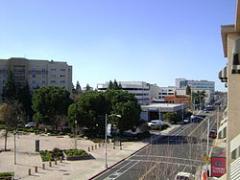

Visalia ( /vaɪËnseɪljÉo/ vy-SAYL-yÉo) is a city situated in the agricultural San Joaquin Valley of California, approximately 230 miles (370 km) southeast of San Francisco, 190 miles (310 km) north of Los Angeles, and 36 miles (58 km) west of Sequoia National Park. The population was 124,442 at the 2010 census.
/vaɪËnseɪljÉo/ vy-SAYL-yÉo) is a city situated in the agricultural San Joaquin Valley of California, approximately 230 miles (370 km) southeast of San Francisco, 190 miles (310 km) north of Los Angeles, and 36 miles (58 km) west of Sequoia National Park. The population was 124,442 at the 2010 census.
Settled in 1852, Visalia is the oldest inhabited inland European settlement between Stockton and Los Angeles. It is the 5th largest city in the San Joaquin Valley after Fresno, Bakersfield, Stockton and Modesto, the 44th most populous in California, and 198th in the United States.
As the county seat of Tulare County, Visalia serves as the economic and governmental center to one of the most productive single agricultural counties in the country.
Yosemite, Sequoia, and Kings Canyon National Parks are located in the nearby Sierra Nevada mountains, the highest mountain range in the contiguous United States. The summit of Mount Whitney, 14,505 feet (4,421 m), is on the border between Tulare and Inyo counties. The western slopes of the Sierra are also home to the ancient Giant Sequoia, some of the largest living single organisms on Earth.
The Visalia Area was first settled by the Yokuts and Mono Native American tribes thousands of years ago. It is unknown when the first Europeans arrived, but the first to make a written record of the area was Pedro Fages in 1722.
When California achieved statehood in 1850, Tulare County did not exist. The land that is now Tulare County was part of the huge County of Mariposa. In 1852, some pioneers settled in the area, then called Four Creeks. The area got its name from the many watershed creeks and rivers flowing from the Sierra Nevada Mountains. All the water resulted in a widespread swampy area with a magnificent oak forest. The industrious group of settlers petitioned the state legislature for county status and on July 10 of that same year, Tulare County became a reality.
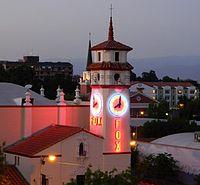
One of the first inhabitants of a fort built by the settlers was Nathaniel Vise. Nathaniel was responsible for surveying the new settlement. In November 1852, he wrote, "The town contains from 60-80 inhabitants, 30 of whom are children of school age. The town is located upon one of the subdivisions of the Kaweah River and is destined to be the county seat of Tulare. au In 1853, that prediction became a reality and Visalia has remained the county seat since that time. Visalia is named for Nathaniel Vise's ancestral home, Visalia, Kentucky.
Early growth in Visalia can be attributed in part to the gold rush along the Kern River. The gold fever brought many transient miners through Visalia along the way and when the lure of gold failed to materialize, many returned to Visalia to live their lives and raise families. In 1859 Visalia was added to John Butterfield's Overland Stage route from St. Louis, Missouri to San Francisco. A plaque commemorating the location can be found at 116 East Main Street. Included in the early crop of citizens were some notorious and nasty individuals who preyed upon the travelers along the Butterfield Stage route. Many saloons and hotels sprouted up around the stage stop downtown and commerce was brisk if a bit risky.
The next memorable event was the arrival of the telegraph in 1860. Visalians then could get timely information of the events taking place on the East Coast which would ultimately develop into the American Civil War. During the Civil War, many citizens of Visalia couldn't decide whether Visalia should stand on the side of the North or the South, so they simply had a Mini Civil War of their own on Main Street. No one really knows the outcome of the war, but apparently it was concluded to the satisfaction of the participants and life returned to normal. The federal government, however, was not so easily convinced, and reacting to concern about sedition, banned Visalia aos pro-South Equal Rights Expositor newspaper and established a military garrison. Camp Babbitt was built in 1862 to stop overt Southern support as well as maintain law and order in the community. During these Civil War years, Visalia was incorporated, which gave the town new rights.
The second incorporation in 1874 moved Visalia into city status with a common council and an ex-officio Mayor and President.
In 1904, the Visalia Electric Railroad was incorporated.
In October 1933, Visalia was the site of a fact-finding committee appointed by Governor James Rolph and charged with investigating labor violence in the San Joaquin cotton strike. Labor activist Caroline Decker led hundreds of strikers in a march on the courthouse, and led the questioning of strikers during the investigation.
Visalia served as a host city for the Amgen Tour of California in 2009 and 2010.
The city is divided into neighborhoods, some of which were incorporated places or communities. There are also several independent cities around Visalia that are popularly grouped with the city of Visalia, due to its immediate vicinity. Generally, the city is divided into the following areas: Downtown Visalia, North Visalia, The Eastside, Southwest Visalia, the Industrial Area, Mooney, and the Westside.
Visalia has a rich architectural history including many extant buildings dating to the mid-late 1800s. Throughout the town center are many historic brick structures, including the Bank of Italy (currently Bank of the Sierra) and the Art Deco/Beaux-Arts Visalia Town Center Post Office, both of which are registered with the National Register of Historic Places. In addition to many other historic buildings and Victorian houses, Visalia is also home to a distinctive Fox Theatre, which was restored by a community group known as "Friends of the Fox" and currently serves as a live venue for music and stage performances.

Visalia is irregularly shaped and covers a total area of 36.3 square miles (94 km2), of which 36.3 square miles (94 km2) is land and 0.05% is covered by water. Visalia is located at 36 °19'27" North, 119 °18'26" West (36.324100, -119.307347).
The highest point in the Visalia-Porterville area is Mount Whitney. Located at the far reaches of the Sierra Nevada roughly 58 miles east of the city, it reaches a height of 14,505 ft (4,421 m). The hilliest parts of the Visalia area are the Venice Hills and the entire Sierra Nevada foothills east of the city. There are four main streams that run through the city. The major stream is the St. John's River, which begins at the diversion dam in the Kaweah River and is largely seasonal. The others are Mill Creek, Cameron Creek, and Packwood Creek. There are also many smaller creeks that flow through the city. The Friant-Kern Canal runs just east of the city along the western edge of the Sierra Nevada Foothills.
Visalia is subject to aftershocks due to its proximity to the Pacific Ring of Fire. The geologic instability produces numerous fault lines both above and below ground, which altogether cause approximately 10,000 earthquakes every year. One of the major fault lines is the San Andreas Fault. No major earthquakes have hit the Visalia area. All but a few quakes are of low intensity and are not felt. Parts of the city are also vulnerable to floods. The San Joaquin Valley and metropolitan areas are also at risk from blind thrust earthquakes.
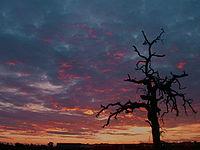
Visalia is somewhat like a Mediterranean climate, but more like a semi-arid climate (Koppen climate classification Bsh), and receives just enough annual precipitation to stay out of Koppen's BWh (desert climate) classification. Visalia enjoys plenty of sunshine throughout the year, with an average of only 26 days with measurable precipitation annually.
The period of April through October is warm to hot and dry with average high temperatures of 74 ae94 °F (23 ae34 °C) and lows of 48 ae65 °F (9 ae18 °C). However, temperatures frequently exceed 100 °F (38 °C) and occasionally reach 105 °F (41 °C).
The period of November through March is mild and somewhat rainy with average high temperatures of 54 ae67 °F (12 ae19 °C) and lows of 36 ae45 °F (2 ae7 °C), but temperatures could occasionally drop to low 30s (~5 °C) or be as high as 70 °F (21 °C) for a few days during winter.
Visalia averages 11 inches (279.40 mm) of precipitation annually, which mainly occurs during the winter and spring (November through April) with generally light rain showers, but sometimes as heavy rainfall and thunderstorms. The valley gets slightly less rainfall, while the mountains get slightly more. Years of average rainfall are rare; the usual pattern is bimodal, with a short string of dry years (perhaps 7 ae8 inches/180 ae200 millimetres) followed by one or two wet years that make up the average. Snowfall is extremely rare in the valley, but the mountains a couple miles east of city limits receive snowfall every winter. The greatest snowfall recorded in Visalia was just below 3 inches (7.62 cm) on January 25, 1999.
The Visalia area is rich in native plant species due in part to a diversity in habitats, including creeks, rivers, hills, and mountains. Native plants include: Incense Cedar (Calocedrus decurrens), Oak (Valley oak), California Bay (Umbellularia californica), Manzanita (Arctostaphylos manzanita), Salvia (Salvia spathacea), Mountain Mahogany (Cercocarpus betuloides), Milkweed (Asclepias speciosa), California fuchsia (Epilobium cleistogamum), Monkeyflower (Mimulus), Penstemon, Western Melica (Melica californica), and Deer Grass (Muhlenbergia rigens).
From the City of Visalia website: "...the city council finds it necessary to establish basic standards, measures and compliance requirements for the preservation and protection of native Valley oak trees and landmark trees..."
Visalia has adopted this ordinance for pruning or removing Valley Oak Trees. The area was once a dense oak woodland and the city is trying to maintain a healthy urban forest partly through preserving Mooney's Grove Park, one of the largest Valley Oak groves in California. Also, just outside the city limits is the Kaweah Oaks Preserve which is a 322-acre nature preserve. It protects one of the last remaining Valley Oak riparian forests in the San Joaquin Valley.
Visalia was the home of the minor league baseball team the Visalia Oaks for almost 30 years. The team's namesake was in recognition of the city's arboreal identity and had the mascot of Oakie, and later Chatter, both gray squirrels.
Owing to geography, heavy reliance on automobiles, and agriculture, Visalia suffers from air pollution in the form of smog. The Visalia area and the rest of the San Joaquin Valley are susceptible to atmospheric inversion, which holds in the exhausts from road vehicles, airplanes, locomotives, agriculture, manufacturing, and other sources. Unlike other cities that rely on rain to clear smog, Visalia gets only 11.03 inches (280.16 mm) of rain each year: pollution accumulates over many consecutive days. Issues of air quality in Visalia and other major cities led to the passage of early national environmental legislation, including the Clean Air Act. More recently, the state of California has led the nation in working to limit pollution by mandating low emission vehicles. Smog levels are only high during summers because it is dry and warm. In the winter, storms help to clear the smog and it is not as much of a problem. Smog should continue to drop in the coming years due to aggressive steps to reduce it, electric and hybrid cars, and other pollution-reducing measures taken.
As a result, pollution levels have dropped in recent decades. The number of Stage 1 smog alerts has declined from over 100 per year in the 1970s to almost zero in the new millennium. Despite improvement, the 2006 annual report of the American Lung Association ranked the city as the 11th most polluted in the country with short-term particle pollution and year-round particle pollution. In 2007 the annual report of the American Lung Association ranked the city as the 4th most polluted in the country with short-term particle pollution and year-round particle pollution. In 2008, the city was ranked the third most polluted and again fourth for highest year-round particulate pollution.
The economy of Visalia is driven by agriculture (especially grapes, olives, cotton, citrus, and nursery products), livestock, and distribution and manufacturing facilities (electronics and paper products are a couple of significant manufacturing sectors). Light manufacturing and industrial/commercial distribution represent the fastest growing portion of Visalia's employer base.
According to the city's 2010 Comprehensive Annual Financial Report, the top ten employers in the city are the County of Tulare, Kaweah Delta Medical Center, Visalia Unified School District, College of the Sequoias, Cigna, the City of Visalia, Turning Point of Central California, Walmart, San Joaquin Valley College and the Visalia Medical Clinic.
The major daily newspaper in the area is the Visalia Times-Delta/Tulare Advanced-Register owned by Gannett Company; El Sol is the city's major Spanish-language paper also produced by Gannett. There are also a number of smaller regional newspapers, alternative weeklies and magazines, including the Valley Voice Newspaper, and Tulare Voice (which focuses coverage on Tulare. The largest real estate publication in Visalia and Tulare County is Today's Real Estate http://www.todaysre.com. Valley Response, ROI Magazine, Living Here (which focuses on living in the Greater Visalia Area). In addition to the English- and Spanish-language papers, numerous local periodicals serve immigrant communities in their native languages, including Armenian, Laos, Hmong, and Chinese. Many cities adjacent to Visalia also have their own daily newspapers whose coverage and availability overlaps into certain Visalia neighborhoods.
Visalia is home to the Visalia Rawhide (a "high-A" class team of the Arizona Diamondbacks) of Minor League Baseball. The Rawhide compete in the California League at Recreation Park.
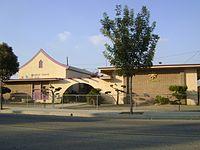
With 233,293 Christians in the Metropolitan Area (85,000 in city proper) the region has a large population of Christians. Churches of the Catholic, Methodist, Presbyterian. Lutheran, Baptist, Church of Christ, Assemblies of God, Church of Jesus Christ of Latter-day Saints, Pentecostal, Seventh-Day Adventist Church, Mennonite, and other denominations can be found throughout the city. Several are located in south Visalia along Caldwell Avenue.
Because of Visalia's large multi-ethnic population, a wide variety of faiths are practiced, including Judaism, Islam, Buddhism, Hinduism, Zoroastrianism, Sikhism, BahR¡'R, various Eastern Orthodox Churches, Sufism and others. Immigrants from Southeast Asia for example, have formed a Buddhist Temple making the city home to the only Buddhist Temple in the Visalia Area.
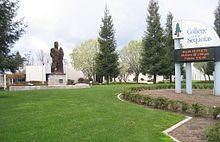
College of the Sequoias, a community college, is the only public college located in Visalia. San Joaquin Valley College and Milan Institute are the only private colleges in the city.
There are two universities with branch campuses located within the city limits: Chapman University and Fresno Pacific University.
Visalia is the only major city in the Central Valley with a population of over 100,000 that does not have a local four year university.
Visalia Unified School District serves the entire city of Visalia, as well as several surrounding communities, with a student population of about 30,000. The Tulare County Public Library operates its largest branch, the Visalia Branch in Downtown Visalia. There are other smaller libraries in Visalia, such as the Visalia Learning Center.
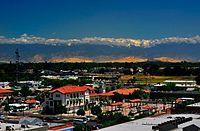
California State Route 99, known as the Pearl Harbor Survivors Memorial Freeway, is the major north-south highway that heads north to Fresno and south to Bakersfield. California State Route 198, the Sequoia Freeway, runs east to Sequoia National Park and west to Hanford. California State Route 63, Mooney Boulevard, heads north towards Orosi and Kings Canyon National Park, and south to Tulare. California State Route 216, Lovers Lane, heads north to Woodlake.
The Visalia Transit (formerly Visalia City Coach) operates environmentally friendly and convenient public transportation to, from and within the communities of Visalia, Goshen, Farmersville and Exeter. The Visalia Transit also provides Dial-A-Ride curb-to-curb para-transit service on a shared-ride, demand-response basis to locations within the city limits of Visalia, Goshen and Farmersville.
The Visalia Towne Trolley serves the Downtown Visalia area.
The Tulare County Area Transit (TCaT) provides the public transit services between Visalia and smaller communities throughout the greater Visalia Area. Service includes Fixed Route and Demand Responsive services that are offered Monday through Saturday.
The Sequoia Shuttle provides convenient, affordable, and an environmentally-friendly alternative form of transportation from Visalia and Three Rivers to the majestic Sequoia National Park.
The Loop is an easy, safe and free way for all school aged kids to get to community centers and recreation centers throughout Visalia where activities for youth are happening.
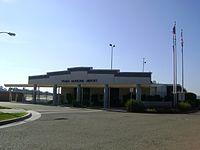
Visalia has one airport, the Visalia Municipal Airport (IATA: VIS, ICAO: KVIS, FAA LID: VIS).
Other nearby commercial airports include:
The 2010 United States Census reported that Visalia had a population of 124,442. The population density was 3,431.4 people per square mile (1,324.9/km ²). The racial makeup of Visalia was 80,203 (64.5%) White, 2,627 (2.1%) African American, 1,730 (1.4%) Native American, 6,768 (5.4%) Asian, 164 (0.1%) Pacific Islander, 27,249 (21.9%) from other races, and 5,701 (4.6%) from two or more races. Hispanic or Latino of any race were 57,262 persons (46.0%).
The Census reported that 123,116 people (98.9% of the population) lived in households, 606 (0.5%) lived in non-institutionalized group quarters, and 720 (0.6%) were institutionalized.
There were 41,349 households, out of which 18,102 (43.8%) had children under the age of 18 living in them, 21,219 (51.3%) were opposite-sex married couples living together, 6,508 (15.7%) had a female householder with no husband present, 2,909 (7.0%) had a male householder with no wife present. There were 3,282 (7.9%) unmarried opposite-sex partnerships, and 314 (0.8%) same-sex married couples or partnerships. 8,383 households (20.3%) were made up of individuals and 3,330 (8.1%) had someone living alone who was 65 years of age or older. The average household size was 2.98. There were 30,636 families (74.1% of all households); the average family size was 3.42.
The population was spread out with 37,406 people (30.1%) under the age of 18, 12,461 people (10.0%) aged 18 to 24, 33,922 people (27.3%) aged 25 to 44, 27,779 people (22.3%) aged 45 to 64, and 12,874 people (10.3%) who were 65 years of age or older. The median age was 31.6 years. For every 100 females there were 95.2 males. For every 100 females age 18 and over, there were 92.1 males.
There were 44,205 housing units at an average density of 1,218.9 per square mile (470.6/km ²), of which 25,380 (61.4%) were owner-occupied, and 15,969 (38.6%) were occupied by renters. The homeowner vacancy rate was 2.6%; the rental vacancy rate was 6.7%. 73,980 people (59.4% of the population) lived in owner-occupied housing units and 49,136 people (39.5%) lived in rental housing units.
According to the 2006 ae2008 American Community Survey, the racial composition of Visalia was as follows:
African Americans make up 2.2% of Visalia's population. According to the survey, there were 2,574 African Americans residing in Visalia.
Native Americans make up 0.7% of Visalia's population. According to the survey, there were 827 Native Americans residing in Visalia.
Asian Americans make up 5.0% of Visalia's population. According to the survey, there were 5,762 Asian Americans residing in Visalia. The seven largest Asian American groups were the following:
Pacific Islander Americans make up 0.1% of Visalia's population. According to the survey, there were 138 Pacific Islander Americans residing in Visalia.
Multiracial Americans make up 2.9% of Visalia's population. According to the survey, there were 3,350 multiracial Americans residing in Visalia. The four main multiracial groups were the following:
Hispanics and Latinos make up 40.6% of Visalia's population. According to the survey, there were 47,251 Hispanics and Latinos residing in Visalia. The four main Hispanic/Latino groups were the following:
White Americans make up 84.0% of Visalia's population. According to the survey, there were 97,735 White Americans residing in Visalia. Much of the European American population is of German, Irish, English, Italian, Russian, Polish, and French descent.
Source:
According to the 2006 ae2008 American Community Survey, the top ten European ancestries were the following:
Source:
The 2000 census recorded 91,565 people, 30,883 households, and 22,901 families residing in the city, with a population density of 3,203.8 people per square mile. There were 32,658 housing units. As of the 2000 US Census, the racial distribution in Visalia was 54.9% White American, 2.3% African American, 6.0% Asian American, 2.4% Native American, 0.3% Pacific Islander, 20.3% from other races, and 4.2% from two or more races. 35.6% of the population was Hispanic or Latino (of any race).
The census indicated that 70.9% spoke English, 12.1% Spanish, 1.0% Lahu, 0.8% Mien, 0.7% Hmong, 0.6% Laotian and 0.5% Tagalog as their first language.
According to the census, 41.1% of households had children under 18, 54.9% were married couples, 14.9% had a female householder with no husband present, and 25.8% were non-families. 20.7% of households were made up of individuals and 8.4% had someone living alone who was 65 years of age or older. The average household size was 2.91 and the average family size 3.37.
The age distribution was: 31.3% under 18, 9.6% from 18 to 24, 28.5% from 25 to 44, 19.7% from 45 to 64, and 10.9% who were 65 or older. The median age was 32. For every 100 females there were 99.4 males. For every 100 females aged 18 and over, there were 88.9 males.
The median income for a household was $53,975, and for a family was $61,823. Males had a median income of $46,423, females $34,265. The per capita income was $23,751. 14.8% of the population and 13.2% of families were below the poverty line. 21.4% of those under the age of 18 and 9.4% of those aged 65 or older were below the poverty line.
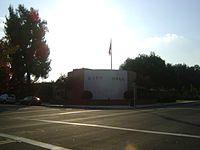
Like much of the San Joaquin Valley, more resident voters are registered in the Republican Party than the Democratic Party.
Of the 51,718 registered voters in Visalia; approximately 31.9% are Democrats and 49.1% are Republicans. The remaining 19.0% are Independents or are registered with one of the many smaller political parties, like the Green Party or the Libertarian Party.
Visalia is a charter city with a city charter approved by the electorate that acts as a "constitution" for the city. Visalia voters, at large, elect a 5-member City Council that serves as the city's legislative and governing body. The city council members serve 4-year terms, and they select one member to serve as mayor and one to serve as vice mayor. The City Council hires a powerful city manager that serves as executive officer, administers city operations, and carries out city policies. Every odd-numbered year either 2 or 3 members are elected by the people to serve a 4-year term. Each March, the City Council meets and chooses one of its members as mayor and one as vice-mayor.
However, on March 5, 2012, the Visalia City Council voted to put on the November 2012 ballot an initiative that would transform the way that Visalia voters get to elect their city council. Currently, the entire city of Visalia votes "at-large" for the 5 members of the Visalia City Council. In November 2012, Visalia voters will be able to decide if they want "district elections" in which the candidate must live in a specific area (or "district"), and only residents of that area cast their votes. The City Government of Visalia has been threatened with a lawsuit from a network of civil-rights attorneys that are charging the city with violating the California Voting Rights Act, passed into law in 2002.
There are dozens of California city governments, school boards, hospital districts, community college districts, and other local governments in this situation: Either Latinos or Asians make up the majority of the residents, yet the local or district-level governing body has only white members (or only one minority member). These entities are being threatened with lawsuits unless they eliminate "at-large" elections and replace them with "district" elections. Because the minority groups are often geographically concentrated, district elections would result in some positions being elected by large enough numbers of minority voters that a member of their group would get elected.
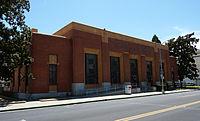
In the state legislature Visalia is located in the 18th Senate District, represented by Republican Jean Fuller, and in the 34th Assembly District, represented by Republican Connie Conway. Federally, Visalia is located in California's 21st congressional district, which has a Cook PVI of R +13 and is represented by Republican Devin Nunes.
The United States Postal Service operates the Town Center Post Office at 111 West Acequeia Avenue, the Visalia Post Office at 2345 West Beech Avenue, and the Millenium Post Office at 100 North Akers Street, The Town Center Post Office received listing in the National Register of Historic Places on January 11, 1985.
Visalia has 2 sister cities, listed chronologically by year joined:
Word Count: 4740







